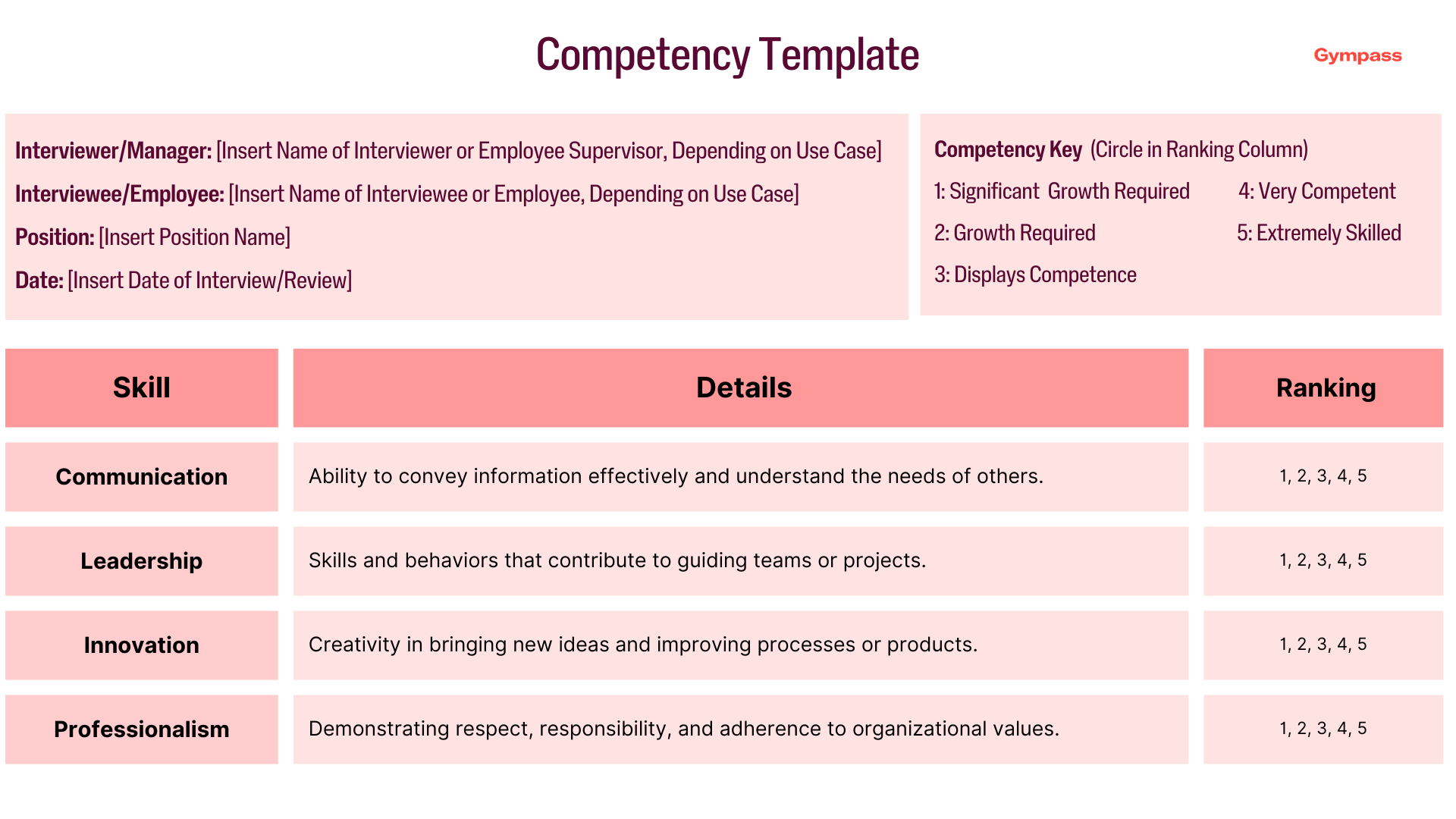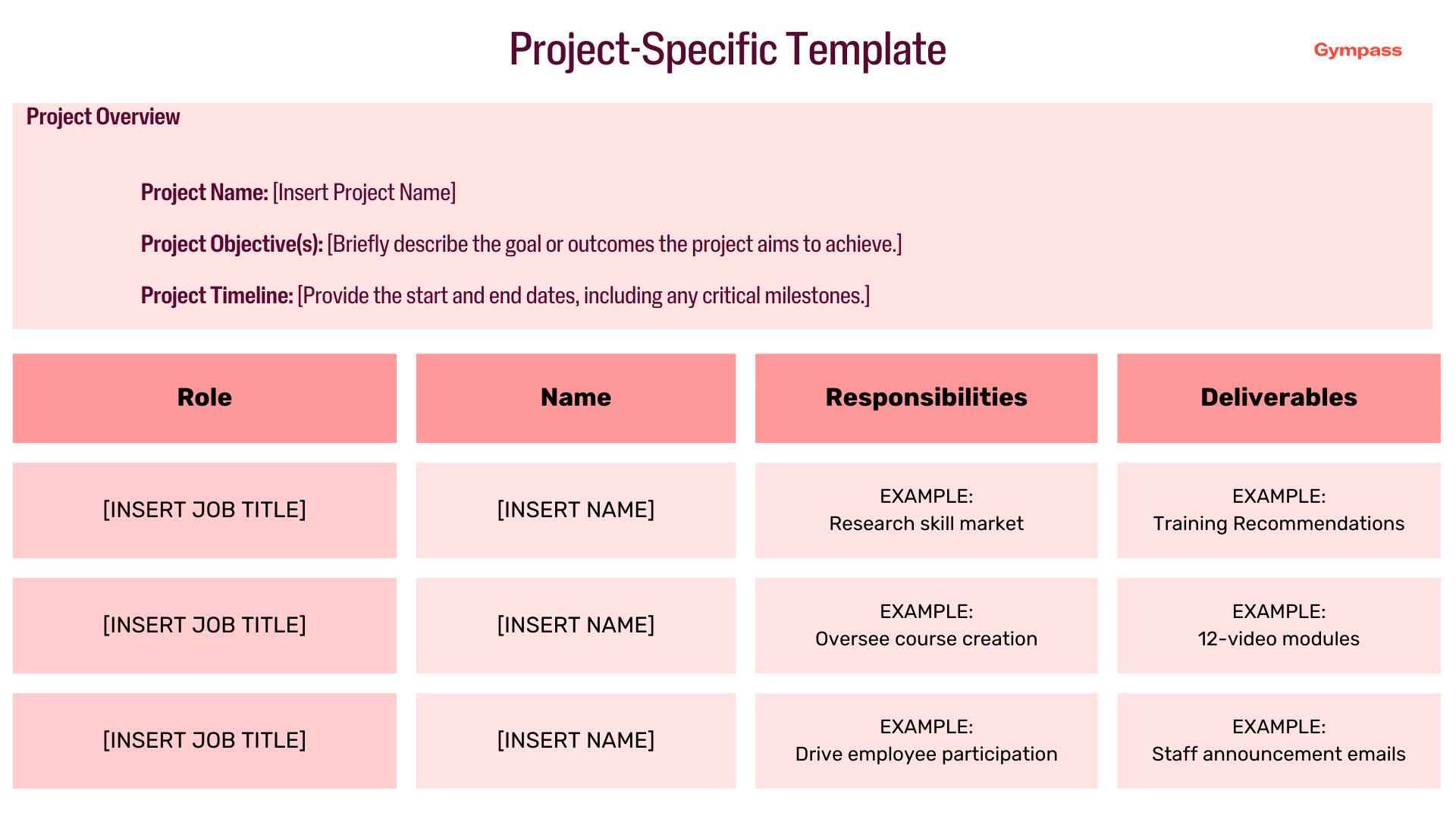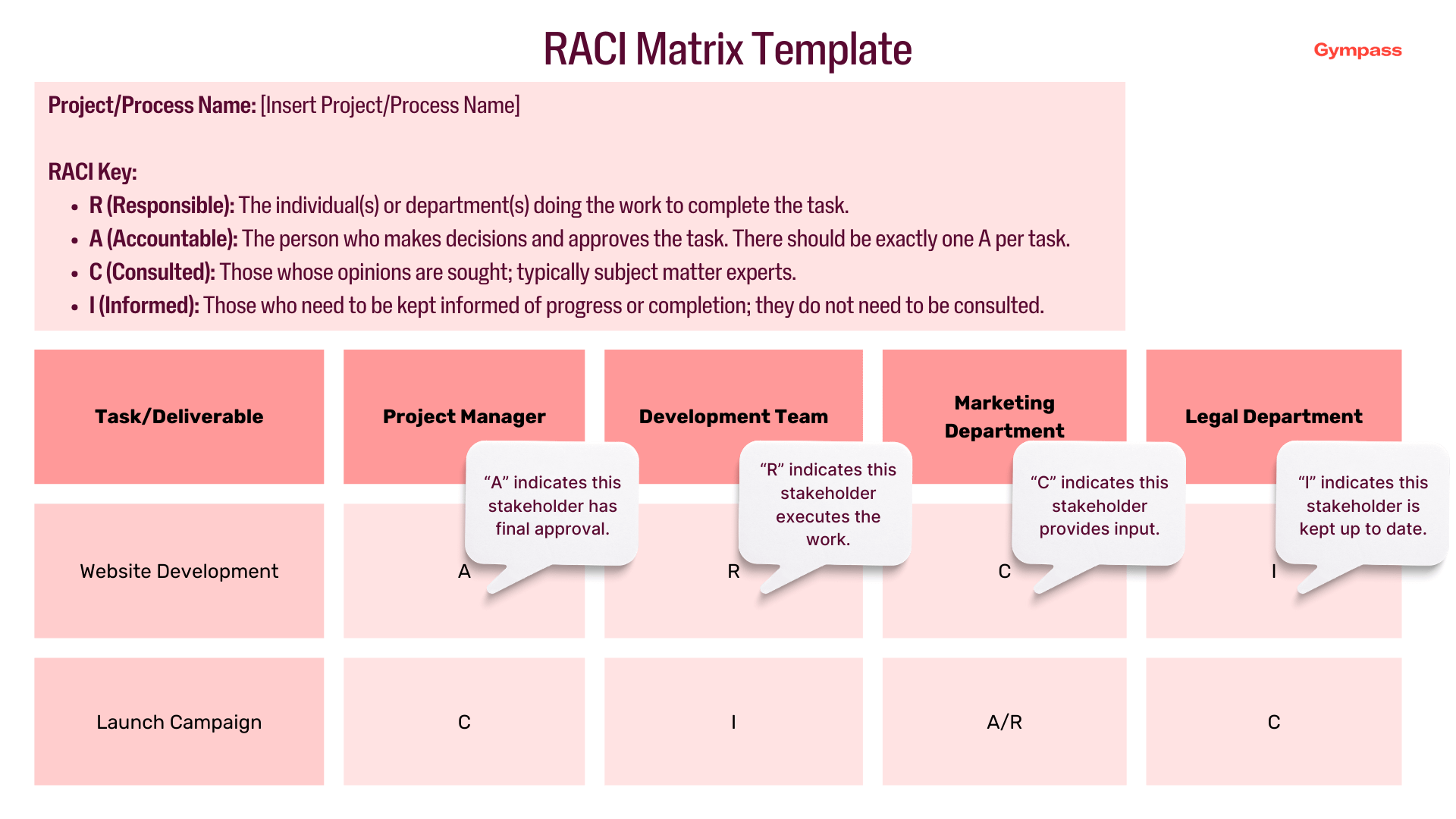Roles and Responsibilities Templates (Four Examples)
Last Updated Jan 28, 2025

Are you struggling with unclear roles and overlapping responsibilities within your team or project?
You're not alone. This common challenge can lead to confusion, reduced productivity, and even conflict among team members. But there's a powerful solution at your fingertips: Roles and responsibilities templates.
These tools are designed to cut through the ambiguity. They provide a clear, actionable framework for defining every team member's role and duties. Whether it's the Basic Structure Template for straightforward role definitions or the detailed RACI Matrix for complex project management, the right tool can significantly boost your team's efficiency.
Here’s how you can leverage these templates to bring clarity and cohesion to your team, from choosing, customizing, and implementing the perfect framework for your needs.
What are Roles and Responsibilities Templates?
Roles and responsibilities templates are valuable tools that outline the duties, expectations, and qualifications required for specific roles and projects within an organization.
For Jobs
When applied to job positions, these templates act as enhanced job descriptions. They not only list the tasks associated with a role but also detail the reporting structure, required skills and competencies, and how the position fits within the organization's structure. This clarity is instrumental in setting expectations for both current and prospective employees, facilitating more effective onboarding and training, and serving as a foundation for performance management and career development discussions.
For Projects
Here, roles and responsibilities templates are tailored to outline the specific contributions of each team member involved in a project. This can vary significantly depending on the project's scope and objectives but typically includes:
- Who is responsible for each task
- Who needs to be consulted or informed about certain aspects of the project
- Who is accountable for the project's success
This ensures that everyone involved has a clear understanding of their roles and how their work contributes to the project's objectives, fostering better collaboration and efficiency.
For HR leaders and project managers alike, these templates are invaluable tools to drive success through clear expectations and aligned effort.
Types of Roles and Responsibilities Templates (Use Cases & Examples)
There are several different roles and responsibilities templates you can use, depending on your goals. Here are the four most common, including when they’re most useful and how to build them.
Basic Structure Template

Advantage
The Basic Structure Template is the epitome of simplicity and clarity. It provides a straightforward outline of a job role, including essential elements like the role title, department, who the role reports to, and the core responsibilities associated with it.
Use Case
This is ideal for small to medium-sized organizations or for roles that do not require a deep level of complexity in their description. It's also perfect for quickly drafting new positions or making clear and concise role definitions available to all team members.
How to Create It:
- Define the Role Title: Start with a clear, descriptive title that reflects the nature of the job.
- Identify the Department: Specify which department the role belongs to, to contextualize its function within the organization.
- Outline the Reporting Line: Clarify who the role reports to, establishing the hierarchical structure and supervisory relationships.
- List Core Responsibilities: Enumerate the key responsibilities associated with the role. Focus on main duties, ensuring they are concise and understandable.
This template is a foundational tool for all roles within the organization, providing a clear snapshot of what each job entails at a basic level.
Competency-Based Template

Advantage
Building on the Basic Structure, the Competency-Based Template addresses the necessary skills and qualifications required to succeed in a role. This makes it a more detailed and comprehensive tool. It helps in aligning roles with the specific competencies that the organization values.
Use Case
This template is particularly useful in industries where specific skills and qualifications are critical for success. It aids in the recruitment process by ensuring candidates understand the competencies required for the role. It also helps managers in evaluating whether team members meet the necessary skill levels for their positions.
How to Create It:
- Include Basic Structure Elements: Start with the elements of the Basic Structure Template as your foundation.
- Detail Required Skills: List the skills necessary for the role. These should include both hard skills (technical abilities) and soft skills (such as communication or leadership).
- Specify Qualifications: Mention any required or preferred qualifications, such as educational background, certifications, or specific experiences.
- Link Competencies to Responsibilities: Make clear connections between the listed competencies and the core responsibilities, illustrating how these skills are applied in the role
The Competency-Based Template is best suited for roles where specific skills directly impact performance, helping in both recruitment and development processes.
Project-Specific Template

Advantage
Tailored to address the needs of individual projects, the Project-Specific Template outlines the roles and responsibilities unique to a particular initiative. It ensures that every team member knows their specific duties, facilitating better coordination and management.
Use Case
Ideal for cross-functional projects involving people from different departments, this template is crucial for managing complex initiatives with diverse tasks. It's a vital tool for project managers looking to keep their teams aligned and focused.
How to Create It:
- Project Overview: Begin with a brief description of the project, including its objectives and timelines.
- Define Roles within the Project: List each team member involved and their specific role title as it pertains to executing this initiative.
- Assign Responsibilities: For each role, clearly outline the tasks and responsibilities assigned to them within the context of the project.
- Establish Milestones: Link responsibilities to project milestones or phases, providing a timeline for when tasks should be completed.
This template ensures that everyone involved understands their duties and how they contribute to the project’s overall success.
RACI Matrix Template

Advantage
The RACI Matrix incorporates the RACI framework, defining who is Responsible, Accountable, Consulted, and Informed for each task. This template excels in clarifying task ownership and communication pathways, reducing overlaps and ensuring all relevant parties are appropriately engaged.
Use Case
This template is invaluable for projects or operational processes that involve multiple stakeholders with varying levels of involvement. It's particularly effective in large organizations or complex projects where clear communication channels and task ownership are essential for success.
How to Create It:
- List Tasks or Deliverables: Start by identifying all tasks, activities, or deliverables involved in the project or process.
- Identify Stakeholders: List all team members, departments, or external parties involved in or affected by these tasks.
- Assign RACI Roles: For each task, assign each stakeholder as Responsible, Accountable, Consulted, or Informed.
- Responsible: Who does the work to complete the task.
- Accountable: Who makes decisions and approves the completion of the task.
- Consulted: Who provides input or feedback before the task is completed.
- Informed: Who needs to be kept updated on the task's progress or completion.
- Review and Adjust: Ensure that each task has at least one person accountable and that responsibilities are evenly distributed. Adjust as necessary to avoid bottlenecks.
The RACI Matrix Template excels in complex projects or ongoing processes, ensuring clear communication and accountability by clarifying the role each stakeholder plays in every task.
By selecting the appropriate roles and responsibilities template, organizations can optimize their team structures and project management approaches. This fosters enhanced efficiency and better communication, improving team performance.
The Benefits of Roles and Responsibilities Templates
Implementing these tools help more than HR leaders. These templates are more than just administrative tools — they are strategic assets that have a host of benefits.
Enhanced Clarity
One of the primary benefits of using these templates is the clarity they provide. By clearly defining what is expected from each role or project, employees have a precise understanding of their responsibilities. This clarity fosters a sense of accountability among team members, as everyone knows who is responsible for what. For HR leaders, this means less time spent mediating misunderstandings and more time focusing on strategic initiatives.
Streamlined Onboarding
Roles and responsibilities templates can speed up time-to-productivity for fresh hires. New employees can hit the ground running, knowing exactly what their role entails and how they fit into the larger organizational framework. This not only accelerates the ramp-up period — it can also enhance the new hire's confidence and job satisfaction from the outset, increasing retention.
Improved Collaboration
These templates serve as a common reference point that can improve communication and collaboration within teams. By outlining roles and responsibilities, team members know whom to approach for specific tasks or information. This reduces bottlenecks and facilitates smoother project execution.
Enhanced Employee Engagement and Satisfaction
When employees have a clear understanding of their roles and how their work contributes to the organization's goals, they are more likely to be engaged and satisfied with their jobs. After all, 89% of HR professionals agree that providing clear employee expectations is one of the best ways to increase employee engagement. This clear connection between individual effort and organizational success can boost morale and foster a sense of belonging and purpose among employees.
Better Performance Management
Roles and responsibilities templates like the competency-based template provide a foundation for more objective and transparent performance evaluations. HR leaders can assess employee performance against clearly defined benchmarks, making it easier to identify areas for improvement, celebrate successes, and ensure alignment with the organization's strategic objectives.
Agility
In today's fast-paced business environment, organizations must be quick and flexible to succeed. Roles and responsibilities templates allow for quick realignment of roles and responsibilities as priorities shift. That helps organizations adapt to changes without losing momentum or focus.
Boost Your Organization’s Performance
Roles and responsibility templates unlock smooth workflows. These tools are your fast track to clarity, making sure everyone knows their role and communication is crystal clear. They're a must-have for HR leaders and project managers looking to keep their teams on task.
But there's more to a winning team than just knowing who does what. That's where Wellhub comes in, bringing wellness full circle by offering everything from gym access to mental wellness support. Imagine a team that's not just well-organized but also well in every sense of the word—energetic, happy, and fully engaged.
Ready to transform your workplace? Talk to a Wellbeing Specialist today!

Company healthcare costs drop by up to 35% with Wellhub*
See how we can help you reduce your healthcare spending.
[*] Based on proprietary research comparing healthcare costs of active Wellhub users to non-users.
You May Also Like:
How to Conduct a Skills Gap Analysis
[Free Download]: Customizable Employee Review Forms
References
- Boskamp, E. (2023, February 16). 22 Must-Know Employee Engagement Statistics Benefits, and More Zippia. Retrieved March 14, 2024, from https://www.zippia.com/advice/employee-engagement-statistics/
- Jobvite. (2018). 2018 Job Seeker Nation Study. Retrieved March 14, 2024, from https://www.jobvite.com/wp-content/uploads/2018/04/2018_Job_Seeker_Nation_Study.pdf
Category
Share

The Wellhub Editorial Team empowers HR leaders to support worker wellbeing. Our original research, trend analyses, and helpful how-tos provide the tools they need to improve workforce wellness in today's fast-shifting professional landscape.
Subscribe
Our weekly newsletter is your source of education and inspiration to help you create a corporate wellness program that actually matters.
Subscribe
Our weekly newsletter is your source of education and inspiration to help you create a corporate wellness program that actually matters.
You May Also Like

Performance Reviews: How to Conduct Employee Evaluations | Wellhub
Discover how to conduct performance reviews to enhance employee growth. Explore key components, best practices, and strategies for success.

Performance Management: A Guide To Drive Growth | Wellhub
Discover how performance management supports employee development and wellbeing—empowering people beyond just meeting the metrics

Employee Feedback That Improves Performance | Wellhub
Positive, constructive and critical feedback all play a part in driving employee performance. Here’s how to use each one.